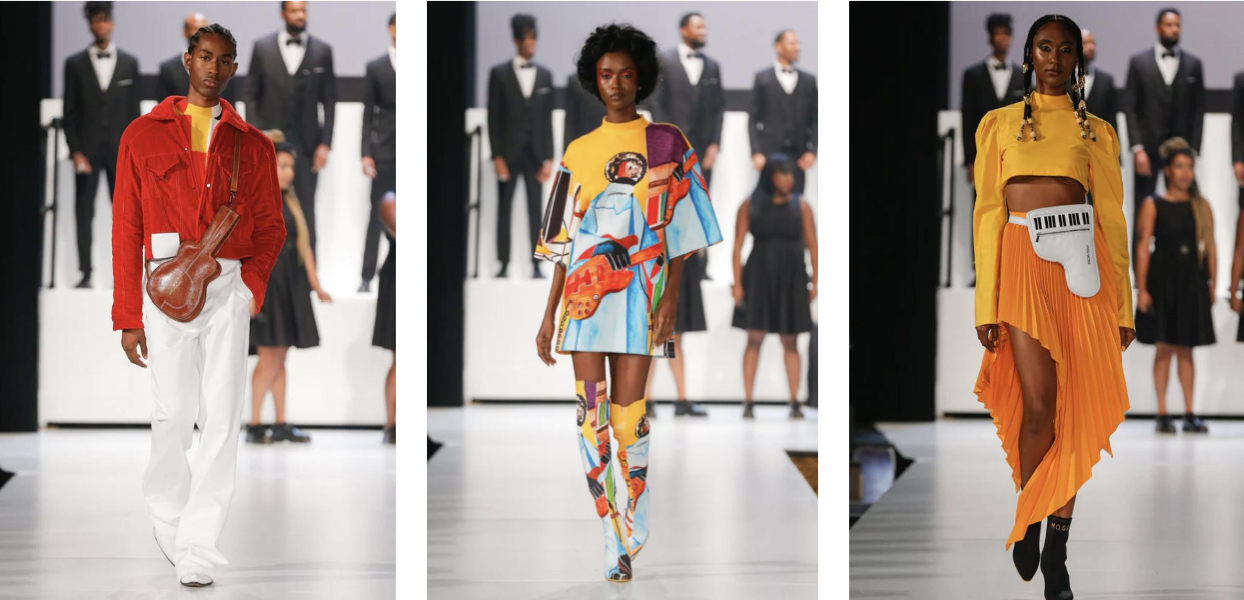The Style of Sound: The Rhythm, Runway, and Originator of Rock and Roll
Sister Rosetta Tharpe was an icon of her time, and her sound continues to have incredible influence on popular music to this day. Because of the erasure she has endured, American fashion brand Pyer Moss curated a one-of-a-kind runway experience in tribute to the musical pioneer.
From the stage to the runway, The Style of Sound is a series that explores the intricate relationships forged between your favorite artists and their iconic fashion statements.
Written by Nico Grayson
Images courtesy of Cameron Robert For Mother Wolf, Underhill Productions
Dubbed the godmother of rock and roll, Sister Rosetta Tharpe was a singer, songwriter, and guitarist who completely changed the landscape of music. As a queer Black woman, Tharpe is widely considered to be the “original soul sister” despite her legacy being widely forgotten about in music history. Thus, her legacy was honored in a 2020 Pyer Moss fashion show entitled “Sister,” which was a celebration of Blackness and was primarily created to counter erasure of Black women from music and pop culture.
Tharpe started out as an artist at age six in her hometown of Cotton Plant, Arkansas where she mastered guitar and attended church conventions alongside her mother, Katie Bell Nubin. In 1938, Tharpe’s talent landed her a gig at The Cotton Club in New York City and not long after, she collaborated with Sammy Price for her biggest hit, “Strange Things Happening Every Day,” which would go down in history as one of the first rock and roll songs.
The singer attained popularity by genre bending gospel and R&B into rock and roll with her full-throated vocals over lively electric guitar. She was among the first recording artists to use heavy distortion on her electric guitar, one of the many techniques that she used to pioneer her distinct musicality. Her methods also made her a key patron in the genesis of electric blues, which served as a foundational genre for popular music in decades to come. Her influence went far, with artists like Johnny Cash, Chuck Berry, and Elvis Presley, all taking many of her stylistic choices, such as her upbeat rhythmic swing, and claiming them as their own.
Despite her talent, legacies like Tharpe’s are often overshadowed by white male artists that dominate the music industry. This issue, however, spans far beyond music and bleeds into all facets of art, such as fashion. To combat this. Creative director Kerby Jean-Raymond unveiled an unforgettable tribute to the rock star with American fashion brand Pyer Moss during New York Spring-Summer Fashion Week in 2020. The show took place in Brooklyn and was staged at the King’s Theater in Jean-Raymond’s native neighborhood, Flatbush.
Photo courtesy of James J. Kriegsmann
Bright colors fluttered down the runway accompanied by accessories referencing Tharpe’s musical talent and performance such as bags and lapels, shaped like guitars. To make the experience that much more eccentric, over 70 ethereal voices of the so-called ‘Pyer Moss Tabernacle Drip Choir Drench in the Blood’ boomed in the background of the show, filling the atmosphere with soulful Gospel music. The show expanded beyond just Tharpe and included influences from other important Black women of the music world that Jean-Raymond felt followed in Tharpe’s lineage such as Anita Baker, Whitney Houston, Missy Elliott, Foxy Brown, Lil’ Kim, Rihanna, and Beyoncé. In addition, Chunky gold beads were threaded onto braids and strung on statement necklaces were molded in the likeness of artists such as Lauryn Hill and Erykah Badu. Pyer Moss also Included art from Jamilla Okubo to create one-of-a-kind drawings of Tharpe to commemorate the late singer.
Photo courtesy of Kena Betancur
Paying homage to Black women, most notably Tharpe, was a political statement for Pyer Moss, bridging the worlds of fashion, music, and activism. Jean-Raymond has been unrepentant when it comes to speaking out on issues of racial injustice. He has repeatedly used his fashion as a platform to bring attention to subjects such as police violence and inequality. He explained in Vogue. This show in particular, however, was meant to reflect what rock and roll look might have been had the music stayed predominately Black. Moments after the show, he said, “I feel like black women are often erased from things, and I wanted to do this specifically for black women. I think relatively few people know that the sound of rock and roll was invented by a queer Black woman in a church.” Furthermore, there is a great significance when discussing these locations like churches, night clubs, and dance halls that served as havens for creativity for Black communities. These few institutions were essential to the continued existence of the black community because they were the few places where black people could congregate, celebrate, or conduct business. It was in these spaces that new ideas, styles, and sounds emerged. Similarly, using the runway as a sacred space to challenge the status quo continues to put brands such as Pyer Moss at the forefront of the fashion industry.



